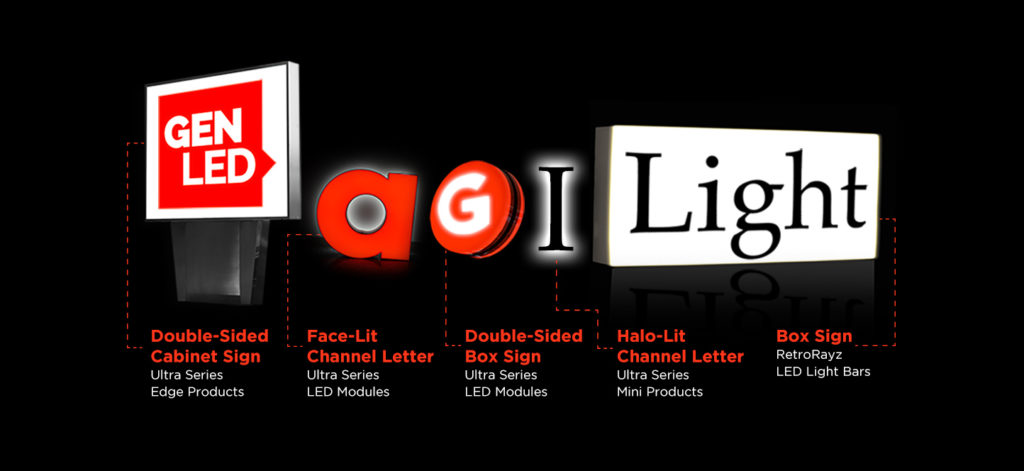BY I.M. LYTEMAN
Premium LED modules are far and away the best solution for signage lighting – they are easily more reliable, durable and cost efficient than their traditional lighting counterparts. LED light systems can be used in a wide range of sign types. Let’s take a look at the most common:
Cabinet Signs or Box Signs
• Typically solid steel or aluminum boxes with a vinyl or acrylic display surface, also called Light Box Signs.
Featuring a simple square or rectangular design and often built so the face can be changed (opened like a cabinet), single-sided cabinet and box signs are usually mounted to a wall. Double-sided cabinet and box signs can be mounted on a pole, pylon or monument. They are best lit internally with LED modules or LED light bars.
Cloud Signs
• Creative custom shapes, ranging from stylized letters to logos.
Most cloud signs tie into a brand identity. They generally feature custom, permanent acrylic display faces. Single-sided cloud signs are often mounted to a wall, while double-sided cloud signs are displayed on poles or pylons. LEDs can be positioned to provide lighting from the front, back or edges of a cloud sign depending on the desired effect.
Channel Letters
• Individual three-dimensional letters mounted to a wall or roof, most often with space inside to include LED lighting.
Commercial channel letters are probably the most popular type of sign. They often feature bright white LEDs that shine outward (they are front- or face-lit) for a bold, prominent effect. Certain branding may call for LEDs in specific static colors or feature white lights that illuminate colors in an acrylic letter’s face.
Halo Lit Letters
• Also called “reverse-lit” or “back-lit” channel letters.
This type of sign uses LEDs mounted behind or in the back of the channel letters, so that the LEDs face the wall. This floods the wall behind the letters with light, creating an ethereal halo effect that makes the sign stand out. Halo lit letters are often only lit at night. Sophisticated LED lighting systems allow for dimming, tunable whites or even changing colors for seasonal or special effects.
Combo Letters
• Channel letters that feature two types of LED lighting.
Creative sign makers can intrigue by combining looks in some channel letters, using both halo lighting to provide background depth and face lighting to direct light toward the viewer. Combo letters often use one color for the halo effect and another for the sign face.
Pylon Signs
• Any sign raised up on a pole or pillar, often for long-distance display.
Pylon signs are generally made with large double-sided cloud, cabinet or box signs – frequently ‘tenant signs’ that display a number of stores in a single shopping complex or a large highway sign for a bigger chain store.
Monument signs
• Signs that are grounded or supported by a base such as brick, concrete or stone.
Often welcome or locational signs that are typically lower to the ground, monument signs are commonly seen outside apartment complexes, schools and doctors’ offices. They can be internally lit single- or double-sided cabinet or box signs, or they can feature a variety of channel letter types.
Neon
• Traditionally glass tubes filled with neon gas that gleams with a static color.
In its heyday, neon lighting was the first choice for bar and diner signs, but it’s no longer the preferred option. In the proper fixtures, modern LEDs marry the classic look of neon with the flexibility, durability and cost efficiency of today’s technology. Using simple DMX controls, premium neon replacement products can even change colors with a dimmer, switch, or basic program.
Spotlight
• A source of light positioned externally above or below an otherwise unlit sign.
Businesses sometimes choose to illuminate signage with spotlight effects such as wall washing and wall grazing. LED modules can be used as wall grazers where the lights are positioned close to a wall or sign at a dramatic, tight angle that highlights the texture of a sign, or they can be used as wall washers where the lights are placed further away and at a wider angle to create an even spread of light across the display face.
